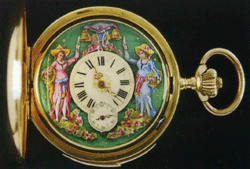|
Antique Repeater Pocket Watches Can Be Costly
By Anne Gilbert
When antique repeater pocket watches come to market, collectors are willing
to pay $10,000 or more if the case is elaborately decorated in gold or enamels.
Double the price if the watch has automatons moving to mark hours or minutes.
The more attractive the automatons, the more they appeal to collectors. If the
case is plain and without automatons, an auction price could be as low as
$1,000. A rare automaton minute repeater gold pocket watch featured in a James
Julia auction on March 12 had a dial with two Victorian ladies in enameled pink
and blue dresses on either side. Their hands were raised to each strike a bell
to mark hours and minutes.
Another type of repeater is the "Carillon" that
has a chromatic sequence of usually three tones created by small bells that
chime every quarter of an hour.
Repeater watches were made over 200 years
ago for the nobility and the wealthy. They were also given as gifts for special
occasions. When they have historical significance, that adds to the price. A
crude hour repeater was made earlier in 1695.
When a pendant is pushed
inward, tiny gongs ring out. The original purpose of the gongs was to tell time
in the dark. The beauty of the case called for elaborate embossing on gold and
the use of enamels and jewels. In addition to striking the hour, some chimed
half hour, quarter hour and minutes. Some also had rotating discs with the face
of the sun for day and the moon depicting night. The sun and moon dial watches
were popular around 1710. After 1710, fashion dictated an ornamental case,
usually of embossed gold, silver or enamel. The minute repeater was first made
in the 1840s. Special repeater watches were created for the Turkish and Oriental
markets in the 19th century.
CLUES: The automaton repeater generally has
two-colored, gold or enameled figures on either side of the dial who strike
imitation bells when the hours and quarters are repeated. A popular style has
Father Time striking a scythe and knights in armor tilting in time to the
blow.
The outward appearance of repeaters can sometimes be deceiving. At
first glance, they may appear like grandpa's old gold pocket watch. However, a
closer look can reveal an extra slide on the side of the case, a striker or an
extra long stem. Then, like magic, they open to reveal designs, often in
precious stones and enamels or automatons.
Early repeaters have been faked
and restored ever since 1800. Strangely enough, over-restored watches that are
genuine can sell for less than the fakes. One of the reasons is that the
forgeries are often so elaborate that it is hard to believe they could be fakes.
A popular, and at the time, cheaply produced automaton repeater was made in
Switzerland in the early 19th century. It had a painted dial with a windmill
automaton.
Some advice for would-be collectors: hammers should strike the
gong, not the case. If they are hitting the case, the sound will be dull. It
should be clear and bold. Collectors are advised not to slam the case shut when
closing any old watch especially repeaters. It must be done carefully when
pushing down on the handle.
Not all fine repeaters were signed. The Swiss
firm of Le Phare made thousands of well made, unsigned repeaters.
The
popularity of repeaters lasted from the early to mid 19th century and ended
around World War I. However, they have never stopped being made by top European
and American companies, with constant innovations.
|

Rare automaton minute
repeater gold pocket watch.
(Photo, James Julia
auctions, Fairfield, ME.)
|